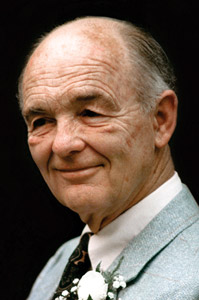Robert Arthur Helliwell
DOI: 10.1063/PT.3.1406
On 3 May 2011, Robert Arthur Helliwell, who broke new ground in the study of the whistler phenomenon and whistler-mode propagation in space, passed away at age 90 at his home in Los Altos Hills, California.
Born on 2 September 1920 in Red Wing, Minnesota, Helliwell spent most of his life near Stanford University in California, where he enrolled in the department of electrical engineering in 1938. He obtained BA and MA degrees in 1942, an engineer’s degree in 1944, and a PhD in 1948, then remained as a faculty member. His PhD thesis, signed by Hugh Skilling, was entitled “Ionospheric virtual height measurements at 100 kilocycles.”
In 1949 Helliwell serendipitously encountered the whistler phenomenon, highly dispersed radiation from lightning in the very low frequency (VLF) range. The previously unknown propagation paths of whistlers in space and their potential use for remote sensing of plasma densities at altitudes of several Earth radii were introduced by Owen Storey in 1953. Helliwell turned his full attention to whistlers and associated radio noise phenomena and established a network of VLF receivers from Alaska to Antarctica during the 1957–58 International Geophysical Year.
In their earliest observations, Helliwell and his associates found evidence that whistlers observed at ground stations propagated on discrete, or “ducted,” paths aligned with the geomagnetic field. Further, the researchers found that the frequency–time dispersion properties of a whistler made it possible to identify the latitude of the field-line path it had followed. Data from the whistler network therefore became the basis for global maps of Earth’s inner plasma envelope, or plasmasphere, with its unexpected sharp outer boundary, the plasmapause (first reported by one of Helliwell’s associates, a former student). The network also provided material for Helliwell’s highly influential 1965 monograph, Whistlers and Related Ionospheric Phenomena (Dover reprint, 2006).
Realizing that above the ionosphere was a rich variety of nonducted whistler-mode waves that did not penetrate to ground receivers, Helliwell worked with colleagues on the pioneering Orbiting Geophysical Observatories in the 1960s. Previously unknown classes of lightning-induced whistlers, transmissions from powerful communication transmitters, and naturally occurring discrete and diffuse VLF emissions were observed and their propagation paths inferred through ray tracing.
More than most whistler observers of his time, Helliwell took a lively interest in the energy and momentum exchanges that could, in principle, take place between subluminously propagating whistlers or other ground-injected VLF waves and the energetic electrons of Earth’s radiation belts. As early as the 1960s, he and his associates were considering the possibility of active experiments in which whistler-mode wave injection might be used to reduce or increase radiation-belt particle energies through cyclotron resonance interactions. He realized early on that although the high-density, low-energy component of Earth’s plasma envelope governed the frequency–time dispersion properties of ground-observed whistlers, the tenuous hot plasma of the radiation belts was the key to understanding the widespread occurrence of discrete or hiss-like emissions that occur either spontaneously or by some in situ triggering mechanisms.
The Siple experimental transmitter in Antarctica, established by Helliwell’s group in 1973, was an engineering marvel. For almost a decade before its closing in 1988, Siple Station was host to crossed 42-km-long horizontal dipoles mounted over a 2-km-thick Antarctic ice sheet. The transmissions, in the low kilohertz range, were received in the Northern Hemisphere geomagnetically conjugate region and provided a rich reservoir of information on what came to be called the coherent wave instability. As a consequence of the CWI, weak Siple-injected narrowband waves propagating along ducts regularly underwent exponential growth by order of 30 dB to saturation levels and also triggered free-running emissions. Although Helliwell’s dream to find a simple explanation for that remarkable phenomenon remained largely unfulfilled, the complexities of the CWI were nonetheless revealed, and today experiment remains well ahead of theory.
Helliwell’s contributions as a researcher, teacher, and member of the science community were many. At Stanford he cultivated a strong sense of group loyalty and a collegial atmosphere in which members could work with a large measure of independence. He authored or coauthored more than 150 papers and supervised the work of 44 doctoral students. He fostered wide-ranging collaborative investigations, including many at Siple Station; served as president of the American Geophysical Union’s section on solar–terrestrial relations; and chaired several committees of the National Research Council. His legacy continues through the contributions of his many former students and the ongoing work of the Stanford VLF Group.

Robert Arthur Helliwell

More about the Authors
Donald Carpenter. Stanford University, Stanford, California.
Umran Inan. Stanford University, Stanford, California.
